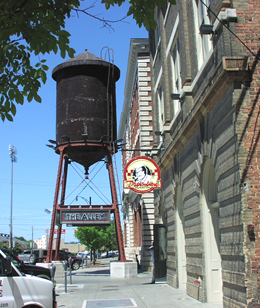I love the idea of the downtown Alley Bars and nightlife, but I’m having a hard time with Jeff’s tank. Pity the poor Architectural Review Board, which had to rule on it as appropriate for a historic district (of which I was a member at its inception a half-century ago). Maybe, if we painted it rocket red…
-Charles Humphries
Below is a nice article by Jeff Benton of the Montgomery Advertiser on the backstory:
Rooftop water tanks to provide water pressure for fire suppression sprinklers and even to provide potable water for use in buildings are commonplace on commercial buildings and apartment houses all across the U.S. They are almost emblematic of New York City.
In the 19th century, New York City ruled that rooftop water tanks were mandatory for buildings higher than six stories. Some have been hidden for aesthetic reasons, but others have been left exposed. From street level they are hardly noticeable.
A few have been creatively re-purposed. In New York’s Greenwich Village, a pre-World War II building’s water tank has been converted into a 100-square-foot structure for reading and relaxation. It is lit by a circular skylight and a 12-foot window, which faces the building’s roof garden.
Several of Montgomery’s early 20th-century water tanks have survived, including one on the 1905 Schloss & Kahn Building (Bishop-Parker Furniture Warehouse) and another on the 1903 Steiner-Lobman Building on the west side of The Alley.
To relocate a rooftop water tank to street level must be unusual, if not unique. After all, it defies reason, because rooftop height was what provided the water pressure. So there was considerable opposition in 2009 to removing a historic Montgomery water tank from its rooftop location and relocating it on the sidewalk and even protruding onto the street itself.
In addition to logic and historic considerations, there was also opposition on aesthetic grounds: the industrial water tank was sited between two of Montgomery’s most distinguished Classical Revival style warehouses, the 1903 Winter Loeb Building and the Steiner-Lobman Building. This juxtaposition of neoclassical and industrial is aesthetically jarring.
Furthermore, the city, which approved this scheme, violated its own procedures for changes within the 45-acre Lower Commerce Street Historical District. The two Classical Revival style buildings marred by the water tank are among the 52 buildings that contribute to the district’s National Register of Historic Places status.
Logic, history, aesthetics, and “law” were trumped by private commercial interests: an unforgettable entrance to the city’s bar and restaurant district. Well, the Eiffel Tower met tremendous opposition in Paris, and was supposed to be merely temporary, but since its erection in 1889 has become one of the most recognizable landmarks in the world.
However, Montgomery is not Paris, and The Alley water tank is not the Eiffel Tower; it is more like McDonald’s golden arches. And, yet, The Alley water tank works.
-Jeff Benton, Montgomery Advertiser
